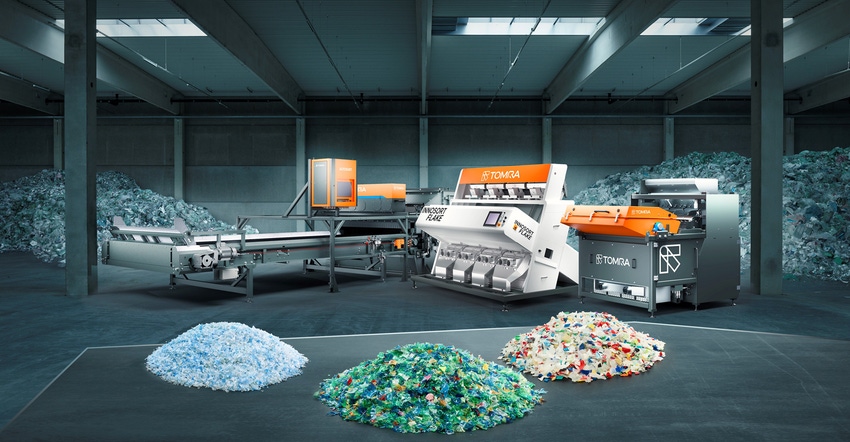
Demand is spiking for high-purity recycled polyolefins (PO), especially polypropylene (PP) and polyethylene (PE), but supply of pristinely sorted PO’s is lagging. This is mainly because, historically, POs have gone into applications that don’t require high purity, and now recyclers and manufacturers want these polymers for high-end products. Norwegian-based TOMRA Sorting Recycling, a developer of sensor-based sorting systems, has made investments to help fill that demand, with the latest outlay being an upgrade to its sortation system that it calls INNOSORT FLAKE. The unit can now precisely sort very miniscule PP and PE flakes. Prior it could sort only PET.
INNOSORT FLAKE can process up to six tons per hour by polymer and by color while conducting multiple sorting steps.
But these materials have to be dealt with before they’re shred into flakes, so TOMRA markets the system along with other machines that each have a role in the multistep process.
Initially, bottles and other packaging are presorted by plastic type and color with a system that TOMRA has branded as AUTOSORT. Next materials are shredded and washed, leaving two options to sort the fine shreds: INNOSORT FLAKE or AUTOSORT FLAKE.
The newly upgraded INNOSORT FLAKE sorts and purifies higher contamination fractions and can sort higher throughputs. AUTOSORT FLAKE works with waste streams of lower contamination but that have high quality demands, such as bottle-to-bottle PET purification.
“These three machines can be combined or run alone. But there is a big benefit of sorting the material with an AUTOSORT first, taking out most of the contaminants, then using the INNOSORT FLAKE or AUTOSORT FLAKE,” says Ida Semb, product manager – AUTOSORT FLAKE, TOMRA Sorting Inc.
“The choice of the flake sorter combination will depend on the purity requirements and application, but recommended is leveraging them both combined if the waste stream is very contaminated,” she says.
Sorting with the INNOSORT FLAKE combined with AUTOSORT delivers up to a 98% purity rate, though this depends on the entire process. Not only sorting, but the rest of the recycling process steps of the circuit, especially the methods for washing, all contribute to final recycled flake purity, according to Carlos Manchado Atienza, regional director Americas, TOMRA Sorting Inc.
The INNOSORT upgrade includes two features that work together. One is a near Infrared (NIR) sensor that picks up on materials’ wavelengths to distinguish one polymer from another that is greater than 2 mm in size. The other is cameras that detect the color of each flake as well as identify details as fine as prints or ink. With this added information, the unit is able to remove unwanted polymers and unwanted colors. Any left-over contaminants, such as labels, metals, and black material, are removed via precisely timed pulses of air.
“So, the new sensor on INNOSORT FLAKE is now able to sort PP, PE, and PET. It can be equipped to sort by color only (camera), by material only (NIR), or by both color and material. And it can sort flakes as small as 2 mm,” says William Zeng, product manager – INNOSORT FLAKE for TOMRA Sorting Inc..
Further, plastics processors will be able to run separate tasks to simultaneously sort different materials independently and/or to simultaneously perform multiple sorting steps (such as second sorts), since INNOSORT FLAKE can sort different materials or contaminants in each chute.
Another growing application is polyvinyl chloride (PVC) flake purification and TOMRA is targeting this market with INNOSORT FLAKE as well.
“PVC sorting is an emerging application in the recycling market and has become quite a hot topic in recent years. TOMRA has machines in the field sorting this type of material, including a large plastic sorting customer in Europe who is using INNOSORT FLAKE for this PVC application,” Zeng says.
TOMRA launched the next generation AUTOSORT in June 2020, referring to it as “Symphony of all Sorts” and introduced the upgraded INNOSORT in October as the “Sound of pure flakes.”
“The Symphony of all Sorts reflects the way in which the latest generation AUTOSORT and its complementary products create a harmonized symphony to sort all kinds of waste with advanced accuracy and sophistication. The machines are like the instruments of an orchestra,” Semb says.
“The ‘Sound of pure flakes’ is part of the Symphony of all Sorts concept, but designed for flake sorting,” she says.
The way that each system component functions is key to quality of the output.
A precise initial presorting step to reduce contamination is important before the shredding and washing processes turn the bottles into flakes. After this, INNOSORT FLAKE and/or AUTOSORT FLAKE do the rest to upgrade the flake to nearly virgin material for the extrusion process, explains Manchado Atienza.
“Additionally, having AUTOSORT in front of the washing-line and INNOSORT FLAKE and/or AUTOSORT FLAKE after, we can detect any error or different signal between both technologies that will indicate that something wrong is happening, for instance an increase of certain material on the flake sorter,” he says.
Until recently purity was not a big issue for recyclers because they only worked with recycling POs for secondary processes, incorporating the material in tables, chairs, and other products with lower quality demands than necessitated by bottle-to-bottle recycling.
Now that the industry is targeting recycled PO for high-end product applications TOMRA believes it made the right decision in taking its technology to the next level.
INNOSORT FLAKE has been commercialized around the world but TOMRA says it cannot name clients.
System components, whether AUTOSORT or the machines to sort flakes, are leveraged primarily by plastics recyclers and bottle-to-bottle recyclers.
“TOMRA technology is revolutionizing the possibility of recycling materials that until now were only used as secondary recycling,” offers Manchado Atienza. “Our new sensors and capabilities can help match the properties of recycled material to virgin material and thus contribute to the great challenges that large companies are undertaking to recycle as much material as possible.”
About the Author(s)
You May Also Like




